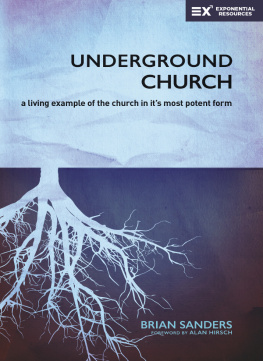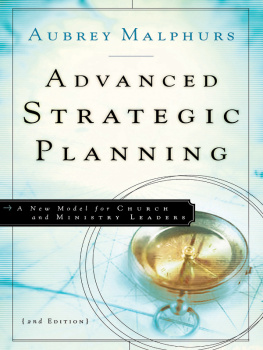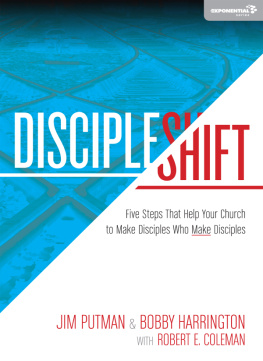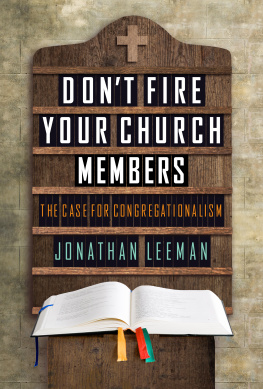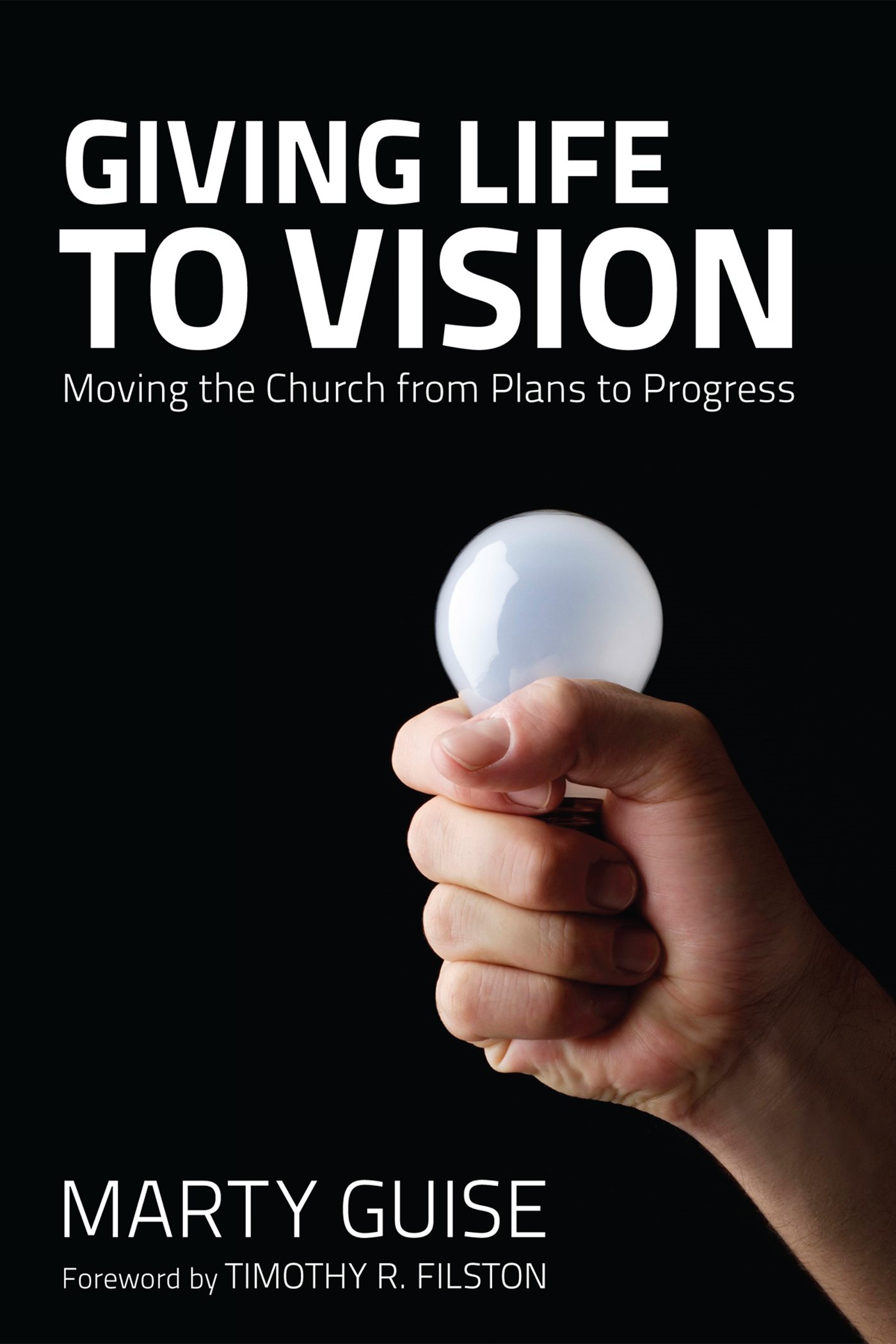Copyright 2012 Marty Guise. All rights reserved. Except for brief quotations in critical publications or reviews, no part of this book may be reproduced in any manner without prior written permission from the publisher. Write: Permissions, Wipf and Stock Publishers, 199 W. 8th Ave., Suite 3, Eugene, OR 97401.
199 W. 8th Ave., Suite 3
Manufactured in the U.S.A.
Unless otherwise noted, all Scripture quotations are from The Holy Bible, English Standard Version (ESV), copyright 2001 by Crossway, a publishing ministry of Good News Publishers. Used by permission. All rights reserved.
Foreword
B ooks about leadership abound. They promise to make more sense out of the way we get things done. I love to read them, if only for the reminder to simplify or just to consider the possibilities. For me though, reading these books is risky. They can make me forget why we all like the same chair at the regular meeting or the same pew on Sunday. Leaders know change is necessary and good, but most people find it threatening and unwelcome. Sometimes in my drive to take things to the next level, I neglect to help people feel permission to look up and ahead.
What Marty Guise has put together here removes barriers to changethe excuses we harbor and even dress-up in spiritual clothing. Most of us are adverse to change because of the pain included. This fact led Jack Welch to tear off all the band-aids at General Electric in his first year. In dealing with issues at church, Marty has a far more endearing approach. Whenever I interact with him, I recognize his deep burden to give congregations permission to be intentional. He urges us to keep swinging with the moving target. But keeping the church aimed at its mission does not happen by accident. A plan is required.
Some pastors operate without much of a plan as though it were a virtue. I once heard an old African-American minister say, God aint early, but Hes always on time. God does call us into seasons of waiting as a discipline of trust. Yet sometimes inaction is only the failure to make better use of what He has already given us.
Reminds me of a light-hearted debate between two preachers. One of them claimed that a Spirit-filled message is never tied to an outline. The other one responded, God may show up once you step into the pulpit, but He meets me beforehand in the study! Mapping out a sermon or a three-year strategic plan does not manage us away from depending upon God. We prepare in order to line-up with Gods mission, so He may work through us more and around us less.
A church in pursuit of a clear vision is not on a quest for the perfect plan and flawless system. The effort is merely to translate Gods timeless charge into the present. The role of vision is a bit like the benefit of picking a fixed point in the distance as you navigate through unknown terrain. The destination itself lies beyond that point but the object helps you keep your bearings.
A well-ordered church lined up with its mission can have an effective witness beyond its walls even in the way it operates. Too often, even large sophisticated church can operate like an extended, dysfunctional family. People shuffle into their familiar roles and stay put. Maybe that is why even top-flight professionals ignore messes at church they would never tolerate in their businesses. Yes, a church community is like family, a living, breathing thing. However, healthy organisms are organized, and their order affects the way they relate to the world around.
To become more intentional is not to loose the ties that bind, trading family for efficiency. A church of any size can become far too complex and layered, in contrast to the unadorned Great Commission. In such systems, the church may succeed at all kinds of things, but with little permission to consider whether these are the right things. They need to become comfortable asking if the real, lived values of the church line-up with the core mission which God has given. They need permission to consider tough questions about whether they are organized to actually do what they profess to value.
Nothing succeeds like success, so a Biblical vision for the church can keep us from succeeding at the wrong thing. Once a church starts succeeding at the wrong thing, it can be terribly difficult to convince anyone something is wide of the mark.
Just keeping things lined up requires more intentionality than church members may realize. A few years ago, a woman joined our staff after volunteering for years. She commented later that she had no idea just how much planning and management went on even after all her volunteer hours. Churches are busy places full of competing personalities, dreams, and agendas. To keep them centered upon mission, we must care enough to be honest about their tangles, to work through those with grace, and to see past them towards a compelling vision. Marty Guises book will help leaders to do just that.
Rev. Dr. Tim Filston
Signal Mountain, Tennessee
Preface
G iving Life to Vision is about a vantage point, yes, and biblical pictures are employed to visualize the landscape of leadership in most, if not all, churches. Yet this perspective is not just another distant description of a static religious institution. Rather, what the reader discovers here is a runway, a well-crafted ramp enabling forward movement.
Those entrusted with leadership in local churches are often willing to serve and expand their leadership skills. The passionate commitment of Lay Renewal Ministries has been exemplified over decades of fruit that has ripened in thousands of churches. LRM prepares the body of Christ for takeoff and propels gospel progress through unity of mind and cohesion of effortin increments that produce forward motion.
You and the leadership team of which you are a part will discover illustration from situations in Gods Word and practical application in the chapters of Giving Life to Vision . Marty Guise, passionately writes this catalyst so that your group of Christ-followers might energetically pursue Kingdom advancement into the culture where God has planted your churchfor His purposesFOR HIS GLORY!
Engaging the guiding principles and action steps set forth in the pages that follow can shift you into FORWARD. Experience the momentum that God brings as your church and its leaders invest together to participate in the commission of the Churchgreatly!
Rev. Gary Bowman
PastorCare Northeast Regional Director
www.pastorcare.org
Acknowledgments
W hen LRM began in 1954, the first files were kept in a shoebox. After decades of service, there is simply no way to acknowledge the thousands of people who have been a part of what has been done. Except, as we say on every event, its not about us. So let me praise God and give Him the glory first, last, and always!






